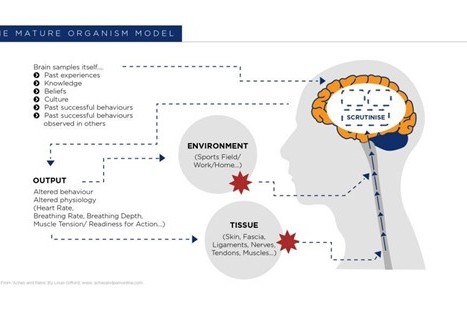Is back pain a result of our beliefs?
Posted Jan 06, 2021 at 16:01
Posted Jan 06, 2021 at 16:01

The Mature Organism Model has been developed by Louis Gifford to provide a broader understanding of pain and to help manage it better.
According to that model our brain constantly not only receives information from our tissues, environment and from sampling itself and in stressful situations it creates an output that main role is to preserve its body and genes.
There is constant information going into our central nervous system from the tissues: tendons, ligaments, muscles, fascia etc and the environment (work, home, sports field)The brain, viewed as a central scrutinising centre, processes all these information to create a response which can take from or physiological changes or behaviours.
Physiological output in a stressful situation may include altered breathing- speed and depth, increased heart rate, muscle tension and readiness for action.
That means that the brain will sample itself before creating a behaviour or physiological response. This sampling includes knowledge of past successful behaviours in similar situation, either our own or observed in others. The experiences stored in our brain are reflection of culture and society, age and life events.
Let�s take as an example a person who grew up seeing their close relative suffering from back pain severely to the point that it affected their ability to carry on with daily life. Once this person experiences back pain they will be more likely to repeat the same patters as this will be an experience stored in their brain associated with the back pain. At the same time, different person who did not have the same exposure/ example, may see back pain as temporary inconvenience that can be easily resolved and therefore increase their chances of recovery.
However, there is also a cultural factor that needs to be taken into consideration. Pain is universal and affects people in all cultures. What is different though, is the approach to pain. Back pain is one of main complains that people come to physicians, musculoskeletal specialists, chiropractors and so on with. It is also one of the main health problems, reasons for work loss, early retirements and disability in the Western culture. Interestingly, surveys carried out in Oman and Nepal has shown that 44% of adults participating had back or neck pain at the time of the interview, which was the same as in the Western surveys at the time (Anderson, 1984) but they did not stop their daily activities or work. People expected neck or back pain to be a part of their life. *Pain is not just a physical thing but a sum of environment, information from tissues and sensory organs, the processes that then happen at the central/ brain level and filters that the brain uses.
If we are being conditioned to stop all activities as a result of pain we reinforce the negative impact it has on our functioning.
Going back to the Mature Organism Model, the vicious circle of input being processed by the brain into negative output can be broken by creating new experiences for the brain. One way of doing it is to learn new ways of movement, getting stimulation to the tissues with manual work or getting adjustments.